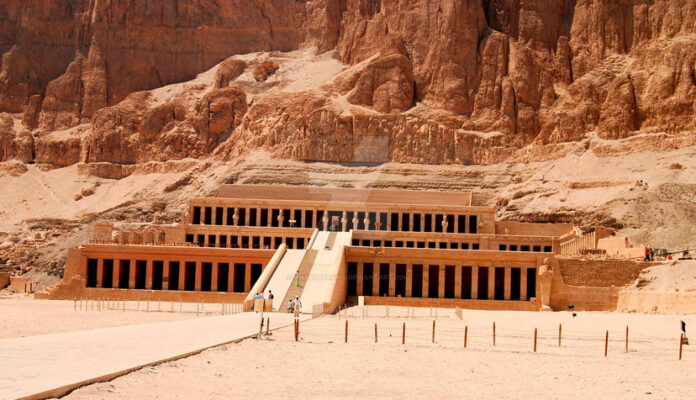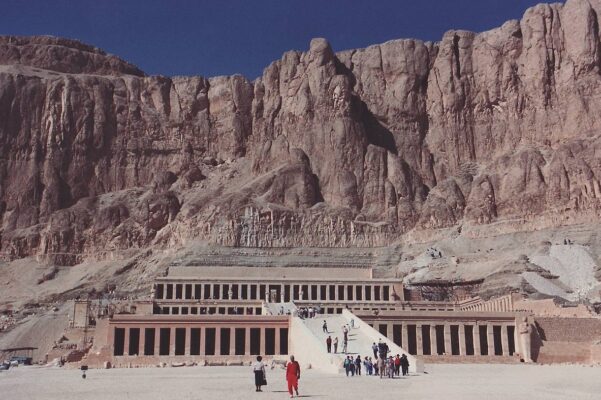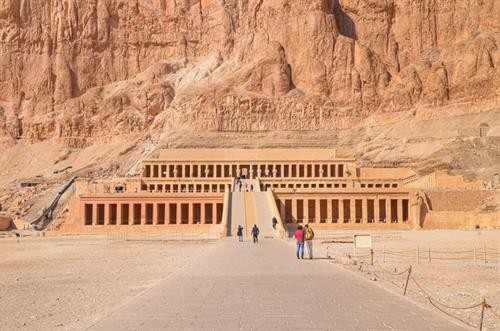The Mortuary Temple of Hatshepsut, located at Deir el-Bahari near the Valley of the Kings, is one of ancient Egypt’s most iconic monuments. This majestic structure, built to honor Queen Hatshepsut—the first female pharaoh of Egypt—showcases her extraordinary reign, architectural vision, and divine legacy. Let’s explore the mysteries with archeology.dulichvn.net

1. The Queen Behind the Monumen
1.1 Who Was Queen Hatshepsut?
Queen Hatshepsut, ruling during the 18th Dynasty, was a trailblazer in Egypt’s history. She claimed the title of Pharaoh, breaking barriers in a male-dominated era, and ruled with remarkable strength and diplomacy.
1.2 Hatshepsut’s Vision for Her Temple
Hatshepsut envisioned the temple as a symbol of her divine connection and eternal legacy. She declared herself the daughter of the god Amun, aligning her reign with the will of the gods.
1.3 Hatshepsut’s Contributions to Ancient Egypt
Beyond her architectural achievements, Hatshepsut is celebrated for her trade expeditions, notably to the land of Punt, which brought wealth and exotic goods to Egypt.

2. The Architectural Marvel of Deir el-Baha
2.1 Unique Design and Layout
The temple’s terraced design, harmonizing with the surrounding cliffs, sets it apart from other mortuary temples. Its three levels, connected by grand ramps, reflect meticulous planning and grandeur.
2.2 The Stunning Reliefs and Art
Intricate carvings within the temple depict significant events, including the Punt Expedition and Hatshepsut’s divine birth, offering insight into her reign and beliefs.
2.3 Integration with Nature
The temple’s location at Deir el-Bahari, surrounded by towering limestone cliffs, creates a stunning backdrop, symbolizing the unity between humanity, nature, and divinity.

3. The Legacy of The Mortuary Temple of Hatshepsut
3.1 A Testament to Female Leadership
The Mortuary Temple stands as a powerful reminder of Hatshepsut’s reign, proving that women could lead with strength, wisdom, and vision.
3.2 Preservation and Restoration Efforts
Ongoing efforts by archaeologists and historians have preserved this monumental site, ensuring its grandeur remains intact for future generations.
3.3 Inspiration for Modern Architecture
The symmetry, design, and integration with natural landscapes have influenced architects worldwide, showcasing ancient Egypt’s innovative spirit.
See more: Standing Tall The Story of Redwood Trees and Their Timeless Beauty
Conclusion
The Mortuary Temple of Hatshepsut is more than an architectural wonder; it is a testament to the vision and legacy of a queen who defied conventions and left an indelible mark on history. Visiting this site is a journey into the heart of ancient Egypt, where beauty, power, and divinity converge in a timeless masterpiece.


CÁC TIN KHÁC
Mark Twain & Olivia Langdon: A 36-Year Love Story Filled with Laughter and Devotion
The Tollund Man: A 2,400-Year-Old Mystery Preserved in a Danish Bog
Skara Brae: Scotland’s Hidden Neolithic Village
Porta Nigra: The Hidden Depths of Trier’s Iconic Roman Gate